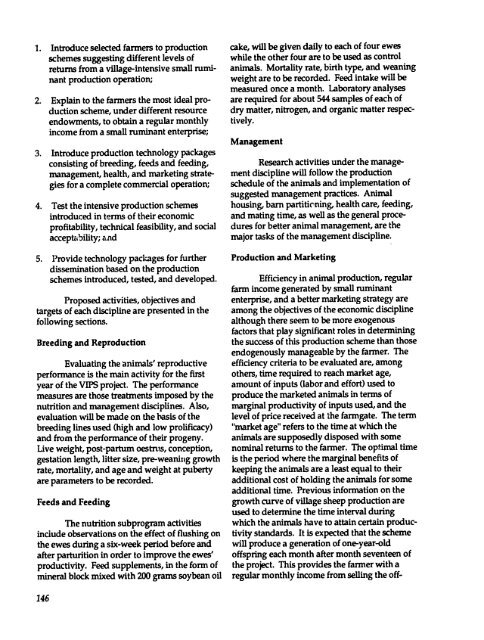Research Results - (PDF, 101 mb) - USAID
Research Results - (PDF, 101 mb) - USAID
Research Results - (PDF, 101 mb) - USAID
Create successful ePaper yourself
Turn your PDF publications into a flip-book with our unique Google optimized e-Paper software.
1. Introduce selected farmers to production<br />
schemes suggesting different levels of<br />
returns from a village-intensive small ruminant<br />
production operation;<br />
2. Explain to the farmers the most ideal production<br />
scheme, under different resource<br />
endowments, to obtain a regular monthly<br />
income from a small ruminant enterprise;<br />
3. Introduce production technology packages<br />
consisting of breeding, feeds and feeding,<br />
management, health, and marketing strategies<br />
for a complete commercial operation;<br />
4. Test the intensive production schemes<br />
introduced in terms of their economic<br />
profitability, technical feasibility, and social<br />
acceptability; and<br />
5. Provide technology paclages for further<br />
dissemination based on the production<br />
schemes introduced, tested, and developed.<br />
Proposed activities, objectives and<br />
targets of each discipline are presented in the<br />
following sections.<br />
Breeding and Reproduction<br />
Evaluating the animals' reproductive<br />
performance is the main activity for the first<br />
year of the VIIS project. The performance<br />
measures are those treatments imposed by the<br />
nutrition and management disciplines. Also,<br />
evaluation will be made on the basis of the<br />
breeding lines used (high and low prolificacy)<br />
and from the performance of their progeny.<br />
Live weight, post-partum oestrus, conception,<br />
gestation length, litter size, pre-weaning growth<br />
rate, mortality, and age and weight at puberty<br />
are parameters to be recorded.<br />
Feeds and Feeding<br />
The nutrition subprogram activities<br />
include observations on the effect of flushing on<br />
the ewes during a six-week period before and<br />
after parturition in order to improve the ewes'<br />
productivity. Feed supplements, in the form of<br />
mineral block mixed with 200 grams soybean oil<br />
146<br />
cake, will be given daily to each of four ewes<br />
while the other four are to be used as control<br />
animals. Mortality rate, birth type, and weaning<br />
weight are to be recorded. Feed intake will be<br />
measured once a month. Laboratory analyses<br />
are required for about 544 samples of each of<br />
dry matter, nitrogen, and organic matter respectively.<br />
Management<br />
<strong>Research</strong> activities under the management<br />
discipline will follow the production<br />
schedule of the animals and implementation of<br />
suggested management practices. Animal<br />
housing, barn partitioning, health care, feeding,<br />
and mating time, as well as the general procedures<br />
for better animal management, are the<br />
major tasks of the management discipline.<br />
Production and Marketing<br />
Efficiency in animal production, regular<br />
farm income generated by small ruminant<br />
enterprise, and a better marketing strategy are<br />
among the objectives of the economic discipline<br />
although there seem to be more exogenous<br />
factors that play significant roles in determining<br />
the success of this production scheme than those<br />
endogenously manageable by the farmer. The<br />
efficiency criteria to be evaluated are, among<br />
others, time required to reach market age,<br />
amount of inputs (labor and effort) used to<br />
produce the marketed animals in terms of<br />
marginal productivity of inputs used, and the<br />
level of price received at the farmgate. The term<br />
"market age" refers to the time at which the<br />
animals are supposedly disposed with some<br />
nominal returns to the farmer. The optimal time<br />
is the period where the marginal benefits of<br />
keeping the animals are a least equal to their<br />
additional cost of holding the animals for some<br />
additional time. Previous information on the<br />
growth curve of village sheep production are<br />
used to determine the time interval during<br />
which the animals have to attain certain productivity<br />
standards. It is expected that the scheme<br />
will produce a generation of one-year-old<br />
offspring each month after month seventeen of<br />
the project. This provides the farmer with a<br />
regular monthly income from selling the off

















